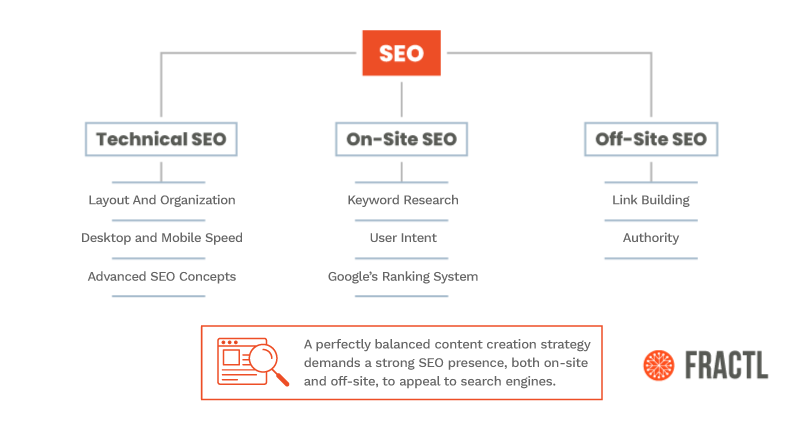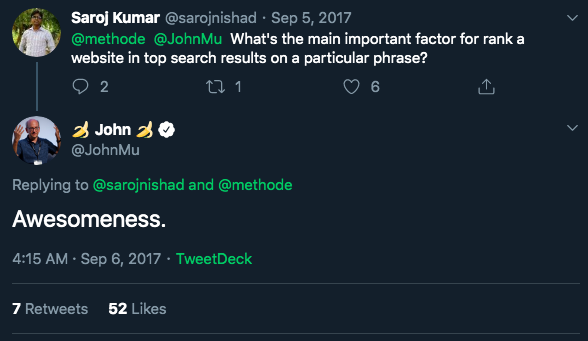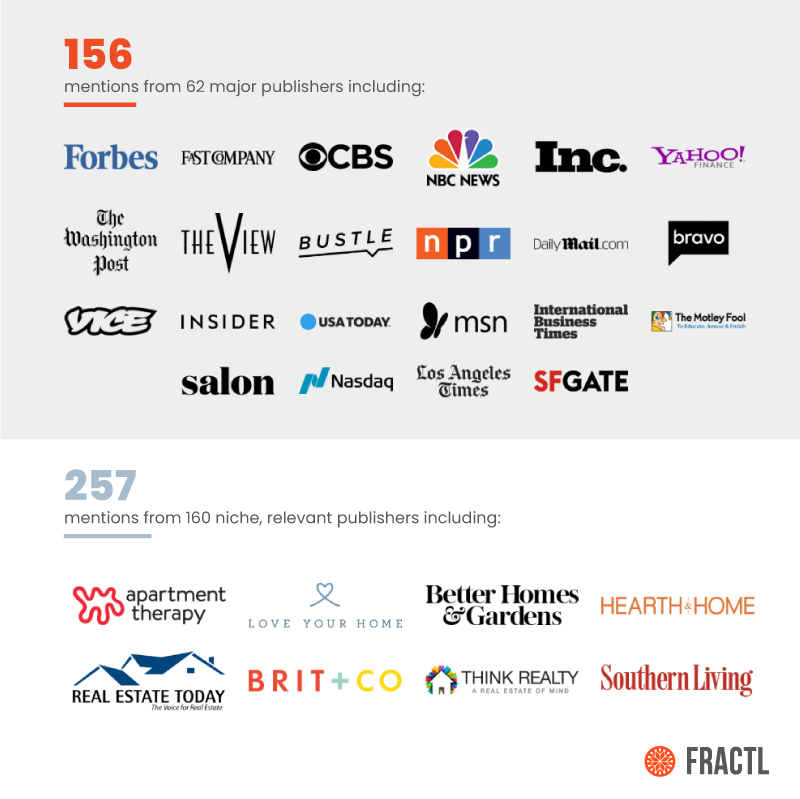Need to find the closest tailor? Looking for tips on cooking a pot roast? Seeking out a contractor nearby?
More than likely, your first step is to consult a search engine such as Google or Bing. Research shows that most people don’t make it past the first page of results, meaning these search engines have gotten pretty good at ranking quality content in the highest positions.
This presents a huge opportunity for brands to provide content that addresses what people are searching for, making it critical that you position your content in a way that is both high-quality and subjectively appealing as well as technically effective at being tracked by search engines.
Search engine optimization (SEO) is the practice of optimizing your content to increase the chances that it’ll appear highly in the search engine’s results.
In the past, people thought of “technical SEO” when they heard the acronym “SEO.” The gist is that you can set up your website and webpages to make it easier for search engine “crawlers” to examine the content and see what it’s about.
But exclusively focusing on that aspect will leave you floundering.
SEO Has Evolved Beyond the Silo
In years past, the division between SEO and other stages of the content marketing process was thought to be wise. Each was considered to be in its own universe and run by separate departments that might not communicate with each other often.
However, in order to succeed at creating content that influences the masses—and actually reaches the masses—we have to remember a key principle of digital marketing: Search engines are constantly refining their algorithms to prioritize the best content on a given topic query. And there are a variety of factors that help search engines define what’s “best” outside of the traditional, technical SEO realm.
In essence, search engines are trying to provide the top-quality answers to the public’s questions. Their algorithms have to determine which sites are authoritative, on-topic, current, reputable, and more. This speaks to the heart of SEO—the intentional optimization of your content so people can search and find you.
However, you can optimize something forever, but if it’s not the best answer to a searcher’s question, it doesn’t stand a chance of rising above the competitive content out there.
Content marketing’s goal is to provide value to your clients/customers and your potential clients/customers. It is a type of inbound marketing—meaning people find your SEO content and thus your brand and its products/services—rather than a type of outbound marketing, which involves you actively pitching your products/services to people.
Content marketing covers the production line of creating content that is aimed to satisfy a target audience’s interests, pain points, curiosity, emotions, spending habits, sharing habits, or any other metric you are looking to track. It could consist of anything from blog posts and white papers to podcasts and video series.
And if it’s done right with SEO in mind, it can be a game-changer for your business.
How SEO and Content Marketing Work Together
If content marketing is about providing value to your audience, and SEO is about helping the search engine algorithms determine the value of your content, then it’s clear content marketing and SEO go hand-in-hand.
Generally speaking, when approaching SEO, there are three elements: technical SEO, on-site SEO, and off-site SEO. Let’s explore how these components bolster content marketing objectives.
Technical SEO: Ensure Your Site is as Optimized As Possible
If a piece of content is represented by a car, technical SEO is everything under the hood. No matter how many hours you spend designing the perfect body and giving the car a shining paint job, it’s useless if the car doesn’t drive.
In the same way, you must devote time to both the quality and technical proficiency of your site, because if it’s super slow or convoluted, that can impact your search engine rankings (and thus whether people read the content you create).
Layout And Organization
The first step to thinking about a technical SEO strategy when creating content is to consider the entire structure and architecture of your website. Simply, does your website have a sensible flow and is it easy to navigate? Search engines will reward websites that have an organized system of interlinking between pages.
When you have pages that do not have any internal links, that is a problem because Google and other search engines may have trouble locating those important pages.
A clearly marked navigation bar, strong internal linking, and an XML sitemap can all be beneficial for your SEO.
Along with website layout comes website design, and as we are entering a phase of “Mobile First” popularity, it is becoming a principal school of thought when mapping out a website.
Security is also a consideration; you can make an easy update to HTTPS for all website pages rather than HTTP, which as the name suggests, is less secure and opens up your pages to potential attacks.
Desktop and Mobile Speed
As we create great content, we need to consider how the text on the page is read by both people and search engines.
When thinking about page optimizations, you want to think about overall website improvements, such as site speed, to allow people to seamlessly access and move around your website.
Without a smooth user experience, people will leave pages that don’t fully load in favor of ones that open quickly. Your website must be able to adapt from desktop to mobile with ease and allow for site visitors to move throughout your pages smoothly and access your products or services information quickly.
Advanced Technical SEO Concepts
The world of SEO is a rabbit hole of concepts that get exponentially more challenging, with some being easily digestible to the average internet browser and some that even go over the heads of expert marketers and programmers.
Some examples of the more advanced adjustments you can make to your technical SEO involve adjustments to your robots.txt file, technical site audits, canonical link elements/duplicate content, redirects, and more. These optimizations require a fine toothed comb through your backend systems, but it is well worth the effort to know your website is operating as smoothly as possible.
On-Site SEO: Considering Your Target Audience and Creating Content for Them
Step 1: Produce great content.
Step 1 – Amended: Produce good content that covers topics people are searching for.
During the ideation process of any piece of content, you must ask yourself: Does the content offer real and demonstrable value to your niche and/or your target community as a whole?
As we mentioned in a previous blog post about SEO and content marketing, the content you’re producing must be relevant to your target audience or you run the risk of high bounce rates, low organic traffic, and a drop in your search engine rankings.
Your audience will consist of different buyer personas and a variety of levels of engagement – at Fractl, we segment our audience into a sections along a funnel: the top, middle, and bottom of the funnel. Contacts are grouped based on their consideration of hiring us.
Determining the communities within your audience and understanding what they’re searching for will guide you in the right direction. This breaks down into two topics: user intent and keyword research.
Understanding what a site visitor has on the mind when they visit your site, what they were thinking about before coming onto your site, and what they are thinking after they leave are all components of determining user intent, or the purpose of someone seeking out a search query.
To figure this out, you can conduct informed keyword research to determine what your target audience is seeking out on Google and how they’re asking those questions, be it long-tail keywords.
Say someone is curious about adopting a healthier lifestyle, and they turn to Google to find some good vegan recipes to try. They start searching for target keywords such as “best vegan recipes” or “easy vegan cooking.” Eventually, they will begin to refine their search, curious about topics such as “one-pot vegan meals” or “overnight vegan oat recipes,” resulting with them landing on a website for a company that sells kitchen supplies and appliances.
Eventually, that same site user may stumble upon more vegan resources linked on those recipe pages, such as vegan cosmetics and clothing, so they explore a variety of brand websites, all representing an opportunity for a sale.
This is a hypothetical scenario of a user journey that spans a variety of topics, vericals, and websites, all stemming from one single search query.
Think about the potential journeys people can go on to arrive at your product and service, and make a list of all the questions they could have at each step. Then, answer those questions with relevant content.
For our client NVision Centers, a California-based lasik and eye surgery brand, we implemented a content marketing strategy focused on boosting educational content. Through the development and production of informational pages about eye care and localized pages for each of the surgery chain’s locations, NVision Centers is now poised as leader in the industry.
Over 100 unique pages were built, covering a range of topics from eye conditions and cataracts to LASIK and beyond. Expanding their content portfolio based on their target audience’s questions led to impressive results.
{{cta(‘5e400d12-3d0a-4c28-b336-a414f1551789′,’justifycenter’)}}
Google: The Amorphous Ranking System
In an effort to protect its intellectual property, technology, and industry secrets, it’s unlikely Google will ever reveal a master list of all ranking factors, leaving many to speculate the missing pieces. John Mueller, Webmaster Trends Analyst at Google, has gone so far as to joke that “Awesomeness” is the key to Google’s decision making process. The mystery of the algorithm aside, Google has publicly confirmed the major categories.
In fact, Google has revealed and confirmed over 200 different ranking signals within a slew of complex algorithms that organize and rank pages according to different search queries. It’s constantly updating its technology with patches to improve the consistency and quality of search results, making it imperative to stay up-to-date on these changes.
As a result, content marketers are constantly testing the algorithm to see what types of stories will make an impact, stand apart from the competition, and earn those top SERP rankings.
Since the way Google—and other search engines—are constantly tinkering with the ranking factors that determine these top rankings, staying informed on these changes is extremely important.
Play around with metadata, title tags, heading text, and more to include key wording and phrases related to your topic. However, don’t go too wild with “keyword stuffing”—Google and readers alike are not fans of text that is over-optimized. And thankfully, Google is getting better and better at recognizing “themes” rather than needing to identify specific keywords, so please don’t get too keyword happy. We’ll get more into how to optimize your text more conceptually in a bit.
Generally speaking, quality reigns. Produce really good content, and Google will reward that. Beyond simply producing good content, a subjective trait at best, the key ranking factors that Google considers in ranking can be summed into the following (some of which are Technical SEO tactics we mentioned earlier):
- Content optimizations: This includes metrics such as total word count, quality of copy, post structure, title tags, meta descriptions, URL, etc.
- Backlinks: Getting high authority publishers to mention and link to your brand. (We’ll explore this more in the next section.)
- “Mobile First”: Google rewards sites that prioritize mobile viewing compatibility when approaching design.
- Site optimizations: Technical upgrades such as page speed, strong site architecture, clean code, securing sites with HTTPS, and more.
- Brand authority:The strength of your brand and its trustworthiness carry weight in Google’s ranking system.
All of these ranking factors will impact how you create content.
Offsite SEO: The Importance of Backlinks and Establishing Your Authority
Giving new content its greatest chance at success involves off-site SEO, as well, which refers to any external signals (not on your own website) that Google uses to identify if your content is quality.
Two of the most important identifiers are backlinks and authority.
{{cta(‘9338ba9a-32ac-4281-86d2-66a082fcb280′,’justifycenter’)}}
Link Building
You’ve created a great piece of content that is written well, rooted in the interests of your target audience and optimized for SEO text throughout the copy.
You may think your job is done, but if you don’t include promotions and link building into your strategy, you may be left with a beautiful piece of content that no one will see.
Google is an enigma, but they have confirmed time and time again that a major player in deciding how to rank a page is links. Why? Because if another site ranks to you, they’re almost vouching for you. They’re saying, we trust this information. And that goes a long way in proving value.
In light of that, all marketers should be putting resources into link building marketing campaigns in order to earn the most potential from your high-quality, optimized content.
The media world is made up of publishers that link to each other, creating connections. These websites often post related types of content or have similar audiences. How do you take advantage of those networks in an effort to create a more efficient pitching strategy to potentially earn thousands of links off one single media mention?
Fractl’s Brand Relationship Manager Domenica D’Ottavio and SVP of Creative Kristin Tynski discuss the long-term link acquisition value of content marketing—specifically, the natural link syndication networks that exist within the publishing world.
By determining which publishers are the best ones for your brand and show the best likelihood of mass syndication, you begin to develop a comprehensive digital PR strategy that is targeted, robust, and intentional.
Authority
So far, we’ve discussed how content and links are key to a complete SEO strategy. Building great content and a robust link portfolio will inevitably lead to your brand’s authority rising, as people begin to trust your brand. And certainly, high-quality backlinks are great authority signals. But other signals, like social mentions/shares, reviews, etc., can also signal high authority.
Building authority is key to our clients’ goals. When working with Porch, a leading home improvement marketplace that seeks to connect homeowners with contractors, we created content projects that engaged relevant and general audiences alike, leading to major media mentions and coverage from top home-related blogs and websites.
We create content that is designed to be shared, whether it be through social media, guest posting, branded media mentions, natural syndication, and more. This sharing is built to attract people and gain traction.
If, as Neil Patel says, SEO and content marketing belong together like a peanut butter and jelly sandwich, then data-driven content marketing and SEO takes that sandwich and reinvents it with brioche bread, artisan preserves, and small batch sugar-free peanut butter.
It is key to produce content that will be valued highly by search engines and web browsers alike.
If part of your content creation strategy is to consider all of the factors that makes content “valuable” according to Google’s algorithms and according to your audience’s needs, you’re on your way to developing a successful content strategy. Good luck in your content marketing efforts!
{{cta(‘f50f91f9-78d2-4efc-a859-5a60f7166c9b’)}}










